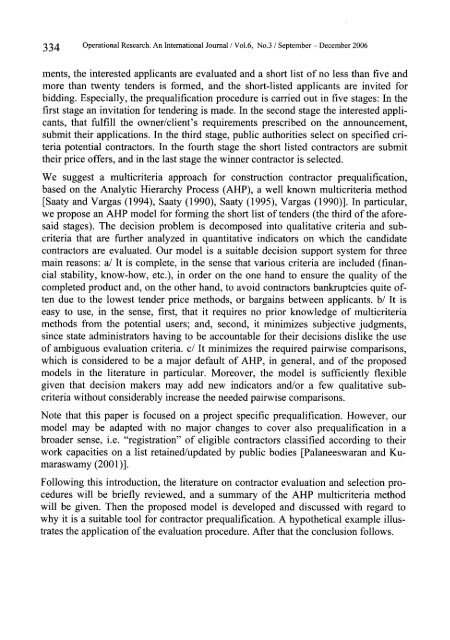An AHP model for construction contractor prequalification
An AHP model for construction contractor prequalification
An AHP model for construction contractor prequalification
You also want an ePaper? Increase the reach of your titles
YUMPU automatically turns print PDFs into web optimized ePapers that Google loves.
334 Operational Research. <strong>An</strong> International Journal / Vol.6, No.3 / September - December 2006<br />
ments, the interested applicants are evaluated and a short list of no less than five and<br />
more than twenty tenders is <strong>for</strong>med, and the short-listed applicants are invited <strong>for</strong><br />
bidding. Especially, the <strong>prequalification</strong> procedure is carried out in five stages: In the<br />
first stage an invitation <strong>for</strong> tendering is made. In the second stage the interested appli-<br />
cants, that fulfill the owner/client's requirements prescribed on the announcement,<br />
submit their applications. In the third stage, public authorities select on specified cri-<br />
teria potential <strong>contractor</strong>s. In the fourth stage the short listed <strong>contractor</strong>s are submit<br />
their price offers, and in the last stage the winner <strong>contractor</strong> is selected.<br />
We suggest a multicriteria approach <strong>for</strong> <strong>construction</strong> <strong>contractor</strong> <strong>prequalification</strong>,<br />
based on the <strong>An</strong>alytic Hierarchy Process (<strong>AHP</strong>), a well known multicriteria method<br />
[Saaty and Vargas (1994), Saaty (1990), Saaty (1995), Vargas (1990)]. In particular,<br />
we propose an <strong>AHP</strong> <strong>model</strong> <strong>for</strong> <strong>for</strong>ming the short list of tenders (the third of the a<strong>for</strong>e-<br />
said stages). The decision problem is decomposed into qualitative criteria and sub-<br />
criteria that are further analyzed in quantitative indicators on which the candidate<br />
<strong>contractor</strong>s are evaluated. Our <strong>model</strong> is a suitable decision support system <strong>for</strong> three<br />
main reasons: a/It is complete, in the sense that various criteria are included (finan-<br />
cial stability, know-how, etc.), in order on the one hand to ensure the quality of the<br />
completed product and, on the other hand, to avoid <strong>contractor</strong>s bankruptcies quite of-<br />
ten due to the lowest tender price methods, or bargains between applicants, b/It is<br />
easy to use, in the sense, first, that it requires no prior knowledge of multicriteria<br />
methods from the potential users; and, second, it minimizes subjective judgments,<br />
since state administrators having to be accountable <strong>for</strong> their decisions dislike the use<br />
of ambiguous evaluation criteria, c/It minimizes the required pairwise comparisons,<br />
which is considered to be a major default of <strong>AHP</strong>, in general, and of the proposed<br />
<strong>model</strong>s in the literature in particular. Moreover, the <strong>model</strong> is sufficiently flexible<br />
given that decision makers may add new indicators and/or a few qualitative sub-<br />
criteria without considerably increase the needed pairwise comparisons.<br />
Note that this paper is focused on a project specific <strong>prequalification</strong>. However, our<br />
<strong>model</strong> may be adapted with no major changes to cover also <strong>prequalification</strong> in a<br />
broader sense, i.e. "registration" of eligible <strong>contractor</strong>s classified according to their<br />
work capacities on a list retained/updated by public bodies [Palaneeswaran and Ku-<br />
maraswamy (2001)].<br />
Following this introduction, the literature on <strong>contractor</strong> evaluation and selection pro-<br />
cedures will be briefly reviewed, and a summary of the <strong>AHP</strong> multicriteria method<br />
will be given. Then the proposed <strong>model</strong> is developed and discussed with regard to<br />
why it is a suitable tool <strong>for</strong> <strong>contractor</strong> <strong>prequalification</strong>. A hypothetical example illus-<br />
trates the application of the evaluation procedure. After that the conclusion follows.




